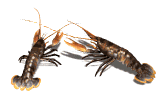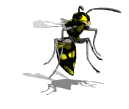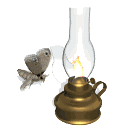

The four main lineages are trilobites (now extinct), chelicerates ( spiders , mites and scorpions), crustaceans ( crabs , shrimp , and barnacles), and uniramians (insects, centipedes, and millipedes).
They have the following adaptations that have contributed to their success:
As body segments became reduced in number and more specialized, appendages also became specialized for feeding, sensing, and locomotion.
As body segments became more specialized, fewer, and grouped or fused, different segments combined to form the head, thorax, and abdomen.
Special tubes called trachea supply oxygen directly to body tissues. This allows high metabolic rates and sustained activity, as in flight.
The compound eye provides a wide angle of vision. Many individual units allow motion perception.
In division of labor, metamorphosis transforms insects from immature larval stages through a pupal stage, to an adult. Larval stages concentrate on feeding and growth, whereas the adults specialize in dispersal and reproduction.
Chelicerates
 Chelicerates originated in the seas. Chelicerates include the terrestrial
spider ,
scorpions ,
ticks ,
mites, and the aquatic
horseshoe crabs.
Chelicerates originated in the seas. Chelicerates include the terrestrial
spider ,
scorpions ,
ticks ,
mites, and the aquatic
horseshoe crabs.
Video (Audio - Not Important) of a horeshoe crab taken in the Storer Hall lobby. Video of the underside of a horseshoe crab taken in the Storer Hall lobby.
Spiders are eight-legged predators that trap insects in their webs.
Video of the black widow spider that lives in my mailbox.
Some mites are free living, while others are serious pests of plants and animals. Ticks are notorious blood-suckers and disease carriers.
Arachnid body features include chelicerae (for piercing), pedipalps (for grasping), an open circulation, and book lungs (for respiration).
Crustaceans
The name is derived from the crusty exoskeleton. Most are important components of food webs and several serve as human food also. Most are marine, some are freshwater, and a few are terrestrial.
The head has two pairs of antenna, two pairs of food-handling appendages (a pair each of mandibles and maxillae), and five pairs of legs.
 Crustaceans include shrimps,
lobsters, crayfishes,
crabs ,
barnacles ,
copepods, and pillbugs .
Crustaceans include shrimps,
lobsters, crayfishes,
crabs ,
barnacles ,
copepods, and pillbugs .

Unusual crustaceans include the tiny copepods that are
integral to marine food webs and the shell-encased barnacles that cause problems when they attach
to wharf pilings.
Gooseneck barnacle video taken at the Monterey Bay Aquarium.
Millipedes and Centipedes
Millipedes and centipedes have a long, segmented body with many legs
Millipedes are slow-moving vegetarians scavengers. The body is cylindrical and there are two pairs of legs on each body segment.
Giant millipede video taken at Picnic Day.
Centipedes move rapidly and prey mostly on small invertebrates. The body is flattened and there is only one pair of legs per body segment.
Insects The body is divided into three regions the head, thorax, and abdomen.
The head is specialized for sensory and feeding functions.
The thorax is specialized for locomotion and usually has three pairs of legs and one or two pairs of wings.
The abdomen contains most of the internal organs and specialized structures for reproduction. There is a three-part gut. Malpighian tubules attach to the midgut and serve in elimination of metabolic waste and aid in water retention.
There are more than 800,000 known species of insects. They are the most successful forms of life that have ever evolved. Insects can produce enormous numbers of offspring. The most successful species are small in size and have a great reproductive capacity. Insects are the only winged invertebrates. Their ability to disperse by flight allows the use of widely ranging food sources.
Metamorphosis through egg , larval, pupal , and adult stages allows fuller exploitation of natures resources. This link is to a series of photos of a butterfly emerging from a chrysalis.
The pictures below will acquaint your (or reacquaint you) with the diversity within the insects and their close relatives (the midterm and final will not contain any questions directly from these pictures and you do not need to memorize the names of all these orders).
 Isoptera -
Termites
Isoptera -
Termites
Cockroach videos taken at Picnic Day.
Thysanura - Silverfish and firebrats
 Odonata - Dragonflies and Damselflies
Odonata - Dragonflies and Damselflies
Parainsecta - Springtails and Proturans
Lady bird beetles taken at Picnic Day.
Hymenoptera - Bees, ants, and wasps


Honey bee queen (with yellow dot)
and workers taken at Picnic Day.
This animation (Audio - Important) describes how honey bees communicate.

Lepidoptera - Butterflies and Moths

Armyworm larva feeding at Picnic Day.
Mosquito larvae and pupae taken at Picnic Day.
 Orthoptera - Crickets and Grasshoppers
Orthoptera - Crickets and Grasshoppers
Hemiptera - true bugs, aphids, cicadas
Strepsiptera - twisted-wing parasites
Neuropterida - lacewings, ant lions, dobsonflies
Lacewing video taken at Picnic Day.
REVIEW: The most successful forms of life that have ever evolved are the��
REVIEW: �_____ are the most evolutionarily successful animals.�
PREVIOUS
NEXT
LECTURE 11 INDEX
MAIN INDEX